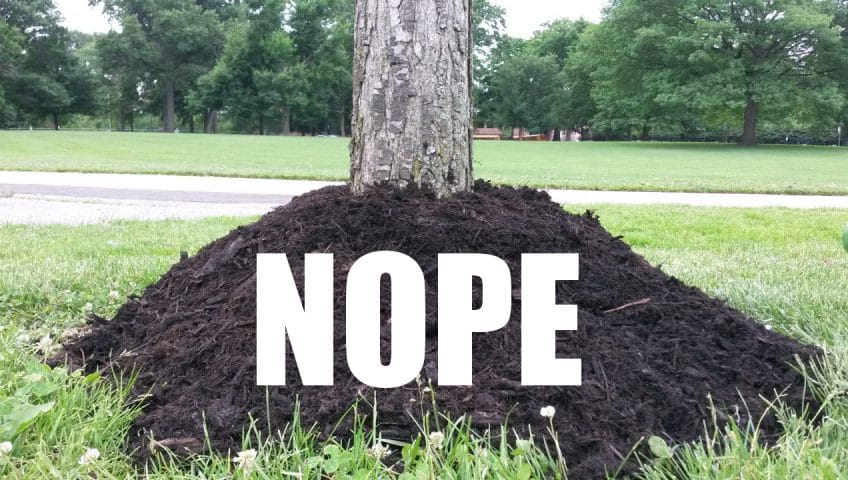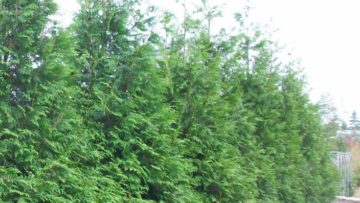Few new landscapes are lucky enough to build around big, healthy shade trees. We often start by planting young trees that need more care than established specimens.
Keeping these young trees healthy means starting them off on the right foot. That requires a combination of soil health, proper planting technique, adequate watering, beneficial fertilization and protection from wind, wildlife and other environmental concerns.
It only takes one of the elements to be out of order to damage your young trees. The symptoms often seem similar to the naked eye, but the causes are often there if you dig beneath the surface. All too often, the causes of decline in young trees are easily fixed, but not easily found.There are myriad factors that will determine the health of your young trees, far more than we can cover in this space. Here, we’ll provide a look at the most common mistakes made in the planting and maintenance of young trees, and provide tips on how to avoid or remedy them.
Common Mistake: The Mulch Volcano
Perhaps the most easily-diagnosed problem in declining young trees, these mountains of mulch are a serious threat to tree health.
We often see young trees covered deep in mulch piles. While mulch is critical to maintaining soil moisture and preventing nutrient competition by turf and weeds, it does much more harm than good when it climbs up the trunk of your young tree.

The proper amount of mulch to lay against the trunk of your young tree is none. Excess mulch can create rot and disease by keeping moisture too far up the trunk of the tree. It also creates space for girdling roots, which encircle the tree trunk as they search through the mulch for nutrients that aren’t there. These girdling roots and bark damage can quickly stunt the growth of young trees. Defoliation, slowed or stunted growth and increasing susceptibility to pest damage are the usual results.
Mulch is best installed at a three-inch average depth, from the edge of the canopy dripline to just outside the trunk. If you can see the tree’s root flare – where the trunk of the tree becomes visibly wider than the rest of the trunk – your young tree is safe from excess mulch or soil.
Remedy
Root-collar excavations and removal of excess mulch and soil can often be enough to restore your young trees to health, if applied in time.
Common Mistake: Improper Watering
Watering is never more critical than in the first few years after planting your new young trees. According to Bartlett Tree Experts, trees demand an inch of water per week during the growing season. If rainfall isn’t significant enough to provide what your young tree needs, it will fail to establish itself fully in its new planting space.
Trees take in a lot of water in their first few years, gathering energy to establish these new roots. While overwatering is always possible, underwatering is a more critical concern. Young trees are less able to withstand drought, high wind and other concerns than established specimens. Proper early watering allows them to take root quickly and become resilient sooner.
As with shrubs and other plants in the landscape, lack of water will manifest itself in browning, drooping or dropped leaves. Slow or no growth will be evident, as well.
Remedy
The good old hose is enough to keep your young trees well-watered, if you’ve got the time. Slow-release tree watering bags are often the best bet. They offer more sustained watering applications with less hassle to you.
Common Mistake: Planting Depth
This is usually a precursor to the mulch volcano. Many young trees are grown and delivered in a burlap and wire cage wrap.
This will help keep the root ball together as your young tree moves from farm to nursery to your home. It’s not an ideal way to promote healthy early root growth, but proper planting will let the tree recover.
Inexperienced installers will often plant young trees with a portion of the root ball well above the surrounding grade. This can be permanently damaging.
The initial installation depth is critical. Too low, and your young tree will be susceptible to rot and disease at the root flare. Too high, and the roots will be more likely to girdle as they search for soil to take hold of. Young trees are unsteady if planted too high. This makes them more susceptible to wind damage or frost heaving in winter climates.
Remedy
A tree that is planted too high or low can be ‘transplanted’ in place by pulling the root ball up temporarily until the proper depth is achieved. Root collar excavations or regrading may also be necessary. None of these are simple fixes — getting things right the first time is critical.
Are your young trees in need of care?
Young tree care is critical. These are often bigger features (and more expensive ones) in any new installation. Letting them decline or die due to improper planting and care is a waste of money and lost opportunity to greatly improve your landscape.
If your young trees are suffering from slow growth or defoliation, you may need to create a care plan. Our plant experts can help you design a tree care program that will help set your young trees up for success.



